The Beauty of the Day-to-Day of 3D Design with John Godfrey
“This is the moment that everything starts to feel real.”

The above phrase, “this is the moment that everything starts to feel real,” is something any graphic designer is thrilled to hear from their client. For prolific designer John Godfrey, the growing accessibility of 3D design software has made these moments feel more frequent than ever before.

John Godfrey, creative director and graphic designer.
John is a self-described “hands-on art director.” He handles design for “pretty much all mediums, from packaging and branding, to print, web and motion graphics.” This doesn’t even make mention of his outstanding work in the entertainment industry.
Alongside partner Clayton D’Mello, he runs Chargefield: a company that, beyond the strict boundaries of design, bills itself as a “creative solutions agency.”
“Clayton has a background in 3D, VFX, and coding. Together we cover a range of skill sets to bring almost any project to life, […] with our network of trusted freelancers,” said John.
“By using Dimension, Clayton can concentrate on his projects, I can pour over the minutiae of my renders, and I can create renders in short periods of time that allows it to fit into the budget for presenting to clients.”
So no matter your position in this industry, if you’re curious about engaging with 3D design software and the changes it can bring to your career, there is no better person to ask. We spoke with John about his career, his thoughts on the industry, and what it was like to create 3D brand visualizations and synthetic photography using Adobe Dimension (you can see the tutorial for this incredible project here).
Easier scaling in 3D
Access to manipulating three axes of scale, instead of two, means that big projects are far simpler to wrap your head around; this goes for designers, clients, and customers alike. “With the Marmont Macarons project, I took the opportunity to use Dimension for something on a larger scale than my usual consumer packaging designs – a food truck.”
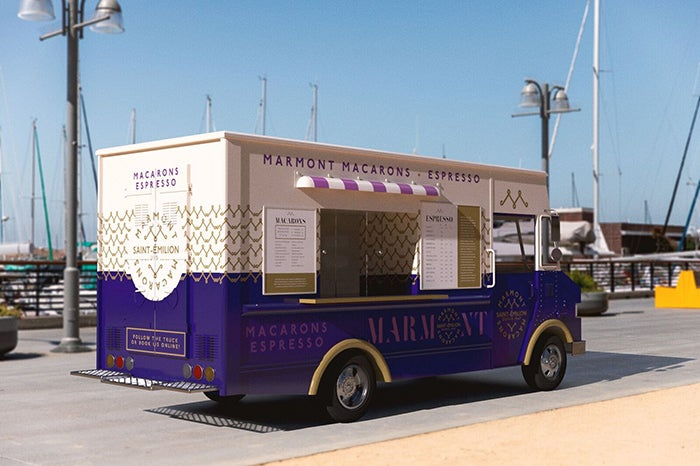
We asked John to create three fictional brands. Check out his Marmont Macarons food truck, designed by John and then composited with a photograph as a background using Adobe Dimension.
“It’s something I’ve always wanted to design as it basically takes packaging and blows the scale up. I was [apprehensive] at first about stepping outside of my small-scale wheelhouse in Dimension, but I think the final product turned out great.” It’s in cases like this, with John’s Macron food truck, that Dimension allows you to play with the spatial aspects of brand visualization. It’s not only about a sign, a logo, or a small objects; it’s also about creating a whole experience and easily swapping out images to quickly see branding in different contexts. For example, designers can place the truck in an entirely different background scenes with accurate lighting and perspective in a matter of seconds, giving people a more holistic feel for the brand beyond just the logo and packaging.
Reliable outcomes for the portfolio
“As a graphic designer, you always want to be sharing new projects when they’re out, and I always try to keep fresh work on Behance and my Adobe Portfolio. The problem is, for packaging design you don’t always have time to shoot product, and the shots your client took of the product might not be right for your portfolio,” said John.
“Scheduling a photoshoot once the client finally sends you samples of the product, and then editing those photos can take months.” But with the help of Dimension, John says he spends far less time and energy on wrangling portfolio material. Now the process is more in his control.
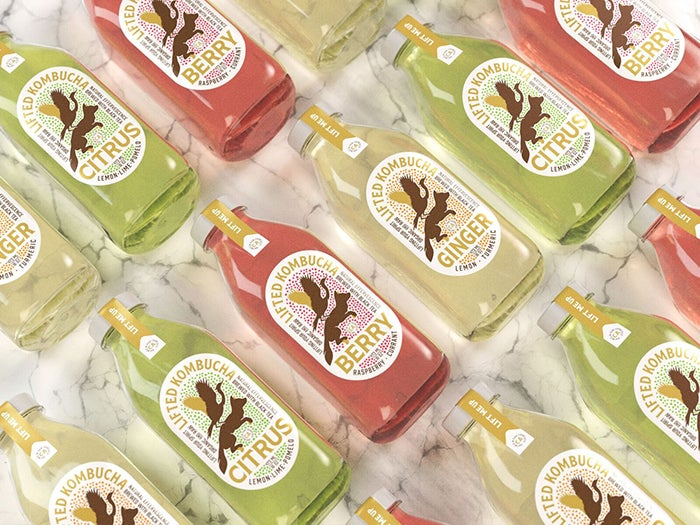
Another of John’s fictional brands, Lifted Kombucha, brought to life in Adobe Dimension.
“Once the client has approved the design, I can now set up renders in Dimension and have everything ready to go for once the client releases the product to market. […] I have a new project to show in my portfolio immediately.”
Using Dimension in the approval stages of his projects, he says, has helped in reducing the time to complete portfolio work even further. Since the file already exists in Dimension, “all that’s left to do is to style the shots in terms of layout, props, lighting, etc.”
Streamline designs across products
Another of John’s favorite 3D building blocks is the incredible variety of starter asset models available.
“Once I’m done creating designs, I can get stock 3D objects to apply virtually any design to — billboards, cans, bottles, boxes, vehicles, apparel – even something as simple as presenting logos can be elevated by applying them to a textured plane in Dimension,” John said.
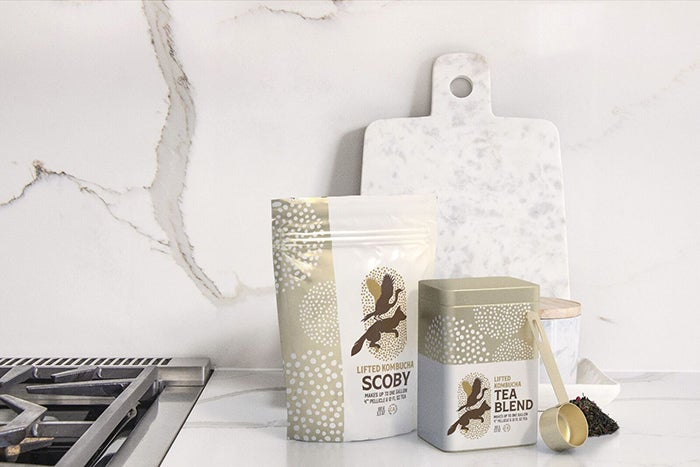
Different package designs for Lifted Kombucha products, visualized by John in Dimension.
“Previously, these kinds of mockups would have to be done in Photoshop, where you have to find a .PSD mockup of just the right type of sign (for example) in just the right environment.” John added.
“Or you have to spend even longer compositing the sign into a more suitable location, then fixing the lighting, and hoping the angle doesn’t look too wonky. Your hands are tied. [Now], you can quickly get both the 3D and image assets you need, apply designs quickly and get lighting and perspective to match automatically, with a bit of tweaking to get it perfect.”
For more inspiration on this front, you can glimpse Godfrey’s process creating the culturally emblematic branding for Queens Hot Sauce.
Stronger client and consumer response
“Dimension has made it easier to present concepts that are a bit more out of the box, and would be difficult to explain visually in other applications — things like special dielines, transparencies used to reveal design features, distortions, finishes, and things like that. […] I have a little more creativity in terms of what I can present to a client.”
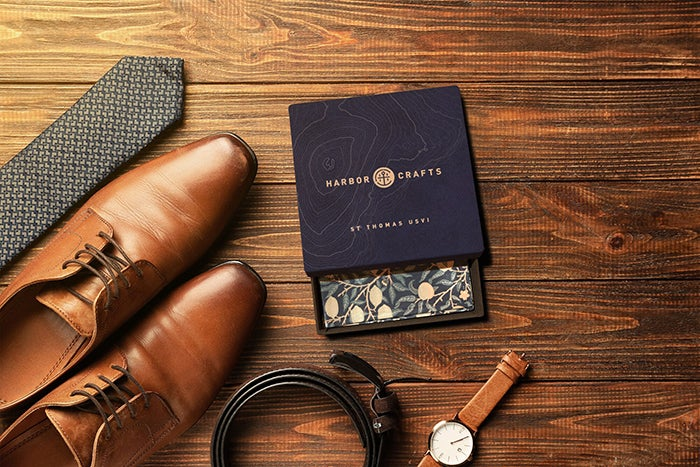
John’s brand Harbor Crafts, which he used to create a tutorial in Dimension.
I would challenge you to show this to average consumers and see how many assume this is a “real” photo, as in, a shot originally snapped with a camera.
For details on how John created the assets for this exact brand, watch his tutorial video here.
Career development is great, but is designing in 3D inspiring?
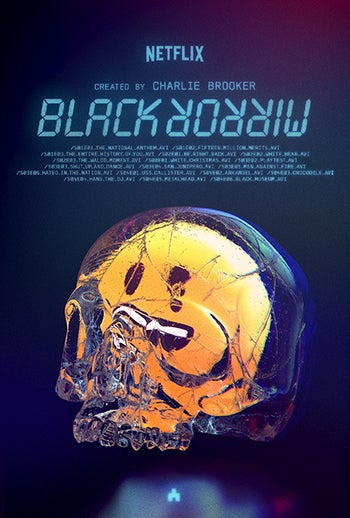
Alternative Black Mirror series poster by John Godfrey made with Adobe Dimension.
Let’s keep our priorities straight. Yes, it’s wonderful that Dimension helps streamline workflows. But, as Godfrey rightly pointed out in this interview on The Dieline, the ease of using this software places an even greater emphasis on what we, as creatives, choose to do with it.
“How are you going to make it stand out? That’s always going to be the challenge. It will always be on the creative side…I always want to continue working on projects in industries that I personally enjoy […] Translating that enjoyment I have of the product into a visual medium. If you love it, I really think it shows through in the work,” he said.
“Since I do a lot of work in movie posters, I’ve been testing the waters in Dimension with a couple [of] alternative movie poster concepts:”
“It uses the application more on the creative side, which I’m excited to explore more of in the future.”
Where is 3D design going from here?
Unsurprisingly, Godfrey sees 3D design becoming more and more common. “As 3D has become both more realistic and more accessible at the same time, I see it becoming integral to more industries.”
“I think it will probably become something more designers will be expected to know to some extent.”
You heard it, designers – take this opportunity to play, push yourselves creatively, diversify your portfolio, streamline your workflow, and show clients that they can trust you to keep innovating.
_For more from John, check out his tutorial, _Rich Package Designs and Product Mock-Ups in Adobe Dimension, and for other Dimension tutorials, click here.